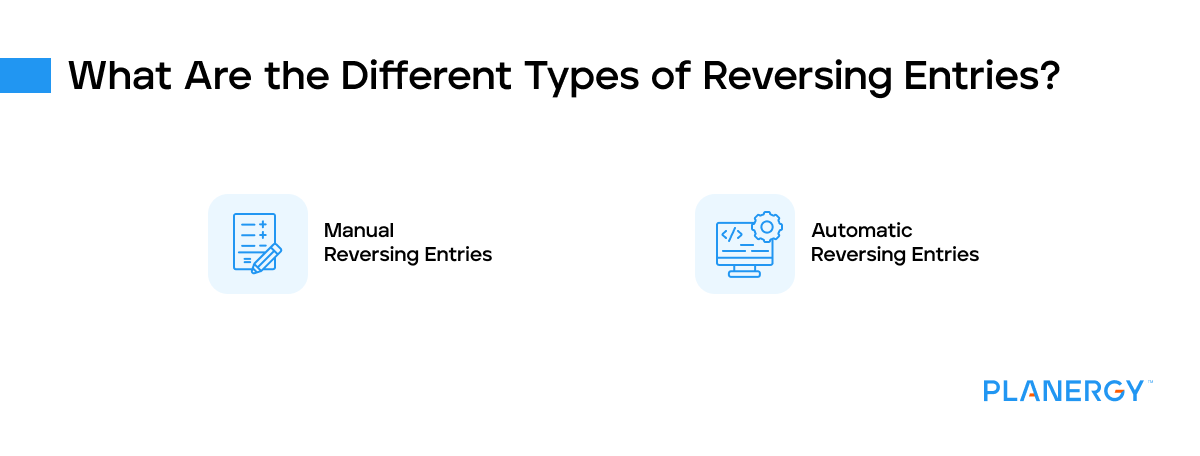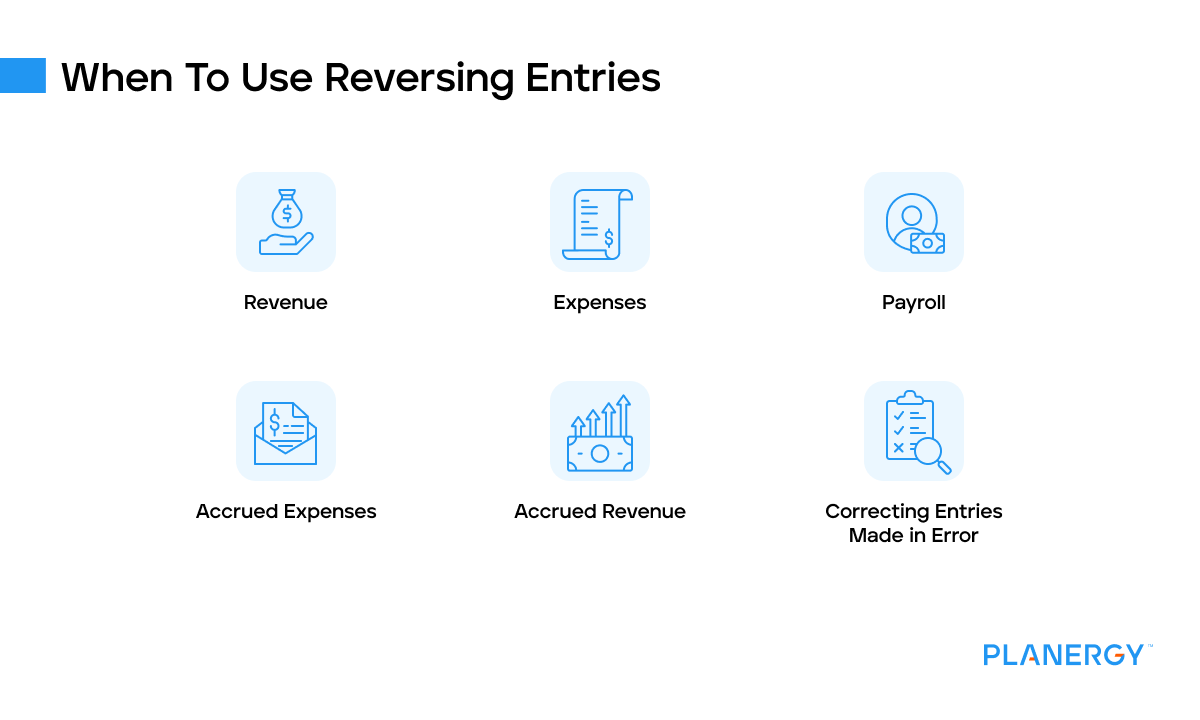If you’re using accrual accounting, chances are you’re already familiar with reversing journal entries. Reversing journal entries are used to reverse an entry made in the previous accounting period for a revenue or expense accrual.
The purpose of the accrual is to ensure that the revenue or expense is recognized in the correct accounting cycle.
Reversing entries can also be used to correct a posting error in the current accounting period.
For instance, if you record an insurance expense to the utility expense account in error, you can use a reversing entry to correct the erroneous posting.
What Are the Different Types of Reversing Entries?
There are two main types of reversing entries that are commonly used in accounting.

Manual Reversing Entries are completed by posting the entry to the general ledger anytime during the month or at year-end. While manual entries are fairly common, they are also prone to errors.
Automatic Reversing Entries are entries that are entered at the end of the current period and then automatically reversed by an accounting software application, ensuring that financial statements are accurate.
How Do You Post Reversing Entries to the General Ledger?
A reversing entry typically includes an expense or revenue account along with the accrued expense or accrued revenue account.
For example, if you’re accruing an expense that has not yet been recorded for the month, you would debit the appropriate expense account and credit the accrued expense account.
When the actual invoice is received the next month, you would reverse the original entry, debiting your accrued expense account and crediting the expense account.
This paves the way for entering the invoice for payment once it’s been approved.
When posting a reversing journal entry, it can help to write a brief explanation of what the journal entry is for.
Let’s say you accrued materials expenses for $2,500 in March. When you post the reversal, you can reference the accrual so that a manager, auditor, or CPA can trace the reversing entry back to the original accrual.
What is the Purpose of Reversing Entries in Accounting?
A reversing entry is used to reverse a previously posted entry or correct one posted in error.
Staying on top of this process keeps financial statements such as your balance sheet, income statement, and trial balance accurate.
For example, if you were to accrue your utility bill in March and didn’t reverse it in April, your utility expense would be overstated.
Using a reversing entry also keeps your audit trail intact.
How Do Reversing Entries Affect Financial Statements?
Reversing entries are used to ensure that financial statements reflect the most current data available.
If reversing entries aren’t made, general ledger balances would be inaccurate, since the original accrued journal entry is part of your ending general ledger balance for the month.
When you receive the invoice for the expense previously accrued and you record it in your accounting software for payment, the expense will be recorded twice if the previous month’s accrual is not reversed.
Why Do You Reverse an Accrual?
An accrual is used to record revenue and expenses in the appropriate month.
If you accrue an expense in April and then enter an invoice for that same expense in May, if the April accrual is not reversed, your expenses will be overstated.
The same issue applies to accrued revenue.
If revenue is earned in April but received in May, you’ll need to accrue the revenue in the month (April) that it was earned and then reverse the accrual in May when the revenue is received.
What Could Cause Accounts Payable to be Understated?
The most common reason that accounts payable are understated is that invoices that are due for the month have not been received and entered into the system.
When that happens, it’s important that those expenses are accrued in the month where the expense occurred and later reversed the following month when the invoice is received.
If expenses are not accrued, your accounts payable balance will be understated, since they have yet to accounted for.
When Can You Use Reversing Entries?
Any time there is an accrual done for an accounting period, you’ll need to post a reversing entry.
However, reversing entries are not just done for revenue and expenses. There are other times when reversing entries are used.

Payroll
Payroll is frequently accrued at month-end, with the entry reversed at the beginning of the month.
For example, if your pay period ends on the last day of April and employees are paid on the 5th of May, April payroll will need to be accrued.
At the beginning of May, you can reverse the accrual made in April because wages expenses will be posted on May 5th.
Accrued Expenses
In many cases, accrued expenses are recorded through accounts payable.
However, if you don’t receive an invoice for an expense that was incurred in the current month, it will need to be accrued at the end of the month and then reversed the following month.
For example, your April electric bill never arrives.
You accrue the expense based on the prior bill. At the beginning of May, you reverse the accrued entry and post the actual expense based on the bill, which was received late.
Accrued Revenue
Accrued revenue is usually accounted for in your accounts receivable account.
Let’s say that someone purchased 1,000 chairs for $15,000 on April 30 but the vendor has not yet issued an invoice for the order.
To properly record the purchase, you’ll need to accrue the revenue in April, when the sale occurred.
At the beginning of May, you’ll reverse the accrual and post the invoice which was issued on May 2.
Correcting Entries Made in Error
Reversing entries can be used to correct mis-postings.
For instance, if you posted your rent expense into the wrong account, you could use a reversing journal entry to reverse the original posting, and then post it to the correct account.
What Are the Benefits of Using Reversing Entries?
Using reversing entries correcting offers many benefits. Some of those benefits include:

Accurate Financial Statements
Posting accruals when necessary is the first step towards creating accurate financial statements.
Reversing those accruals the following month is also a necessity for maintaining financial reporting accuracy for the next accounting period.
Maintains an Audit Trail
Simply deleting an inaccurate journal entry can raise suspicion, should your business be audited.
Instead, by reversing the original entry, you’ll maintain an audit trail that documents the changes.
Increased Efficiency
If your software does not provide an automatic reversing entry option, you can write up the reversals in advance and enter them at the beginning of the month.
What is the Difference Between a Closing and a Reversing Entry?
A closing entry is used at the end of an accounting period to account for revenue and expenses that have been incurred during the month but not yet accounted for.
In the majority of cases, a closing entry is an entry that will need to be reversed the following month, except for depreciation expenses, which are recorded as an adjusting entry for month-end but do not need to be reversed.
A reversing entry is indicative of an entry that has already been made and needs to be reversed. In most cases, reversing entries are used to reverse accruals but can also be used to correct an entry that was posted in error.
What Are Some Examples of Reversing Entries?
The most important thing to remember about reversing journal entries is that you must remember to complete them.
If your software is able to automatically reverse your accruals, then you won’t have to remember to complete them at the beginning of the month.
But for those using manual systems or software that does not automatically reverse accrued entries, you’ll need to remember to make them at the beginning of each month.
Let’s say that you order $15,000 worth of materials from your supplier in the last week of March.
There’s no way that you will have the invoice in March, but you want to make sure that the expense is recorded in the month that the purchase was made.
To do that, you’ll first accrue the expense.
| Date | Account | Debit | Credit |
|---|---|---|---|
| 3/31/2025 | Materials Expense | $15,000 | |
| 3/31/2025 | Accrued Expense | $15,000 | |
| To Accrue March Expense |
This entry will ensure that the expense is recorded in March when it was incurred.
Now, it’s April 1, and you want to reverse the original accrual since you’ll be receiving the invoice for the materials shortly.
Note that the reverse entry is an exact reversal of the original accrual entry.
| Date | Account | Debit | Credit |
|---|---|---|---|
| 4/01/2025 | Accrued Expense | $15,000 | |
| 4/01/2025 | Materials Expense | $15,000 | |
| To Reverse March Accrual |
The last step is to enter the invoice for the materials once it’s received.
This entry will be posted to your accounts payable account.
| Date | Account | Debit | Credit |
|---|---|---|---|
| 4/01/2025 | Materials Expense | $15,000 | |
| 4/01/2025 | Accounts Payable | $15,000 | |
| Materials Expense |
Next, we’ll take a look at a payroll accrual. In this example, we’ll say the payday was May 10, with 2 days in April and 8 days in May included in that payroll date.
To be sure that payroll expense is properly recorded for April, you’ll have to accrue the two days of pay for that month.
Let’s say the payroll total was $10,000, with the two days of pay in April totaling $2,000. Here’s how to record the accrual and the reversal, as well as the total payroll cost.
| Date | Account | Debit | Credit |
|---|---|---|---|
| 4/30/2025 | Salaries Expense | $2,000 | |
| 4/30/2025 | Accrued Payroll | $2,000 | |
| To Accrue April Payroll |
The entry above will ensure that April payroll expenses are accurate.
You can reverse the above accrual entry immediately once the new month begins.
| Date | Account | Debit | Credit |
|---|---|---|---|
| 5/01/2025 | Accrued Payroll | $2,000 | |
| 5/01/2025 | Salaries Expense | $2,000 | |
| To Reverse April Payroll Accrual |
When payroll posts on May 10, the payroll entry will include the entire payroll amount of $10,000, which includes the two days in April.
However, because you reversed the April payroll accrual entry, the payroll amount will not be overstated.
| Date | Account | Debit | Credit |
|---|---|---|---|
| 5/10/2025 | Salaries Expense | $10,000 | |
| 5/10/2025 | Cash Account | $10,000 | |
| To Accrue March Expense |
Reversing Entries Are Part of the Accounting Process
If you’re using double-entry accounting, accruals reversing entries are part of your accounting processes.
While reversing entries is a simple process, the biggest issue with reversing entries is remembering to complete them.
If you’re struggling to remember to reverse accrued accounting entries, switching to an automated accounting system that automatically does the work for you may be the best solution for maintaining an accurate general ledger and up-to-date financial statements.




